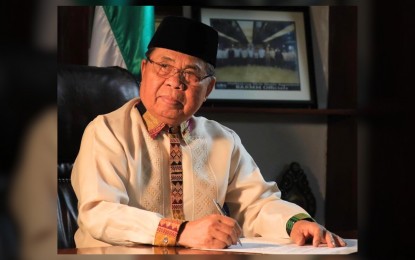From The Diplomat (Feb 2, 2024): The December 2023 Marawi Bombing and the Region’s Unending Terror Threat (By Jasminder Singh and Muhammad Haziq Jani)
The deadly bombing of a Catholic Mass in Marawi City ended years of relative peace in Mindanao. It is a reminder of the need for continued vigilance.
 Law enforcement investigate the scene of a bombing at Mindanao State University, Marawi, December 3, 2023. Credit: Facebook/Provincial Government of Lanao Del Sur
Law enforcement investigate the scene of a bombing at Mindanao State University, Marawi, December 3, 2023. Credit: Facebook/Provincial Government of Lanao Del SurOn December 3, terrorists from the Islamic State (IS) affiliate Daulah Islamiyah Philippines (DIP) detonated an improvised explosive device during a Catholic mass in Marawi City. DIP claimed responsibility for the attack which killed four and wounded 50 civilians who attended the mass in a gymnasium at Mindanao State University. The venue hosts many Christian students, despite being located in a Muslim-majority region of the Philippines.
IS-affiliated terrorists in the Philippines, including DIP, have conducted a number of other bombings in recent years, such as the bombing of two buses in North Cotabato in 2022 as well as roadside bombings in Basilan in the Sulu Archipelago the year prior. However, DIP has more recently been incapacitated by constant military operations by the Armed Forces of the Philippines (AFP) aimed at eradicating the group. More than 1,000 militant Islamists – some affiliated to IS – have also
surrendered to government authorities since the five month-long counter-siege to recapture Marawi from terrorist control in 2017. Many have cited exhaustion, hunger, fear, disillusionment with the terrorist treatment of civilians and extremist doctrines, the loss of leaders, and the growing irrelevance of militancy given the success of the Bangsamoro peace process since 2014.
Despite counterterrorism gains and the post-war rejection of militancy and violence by Marawi’s residents, the December 2023 attack marked the unwelcomed return of terrorist activity in a city that had only recently began to show signs of recovery. The blast also coincided with the fourth day of the Mindanao Week of Peace, an annual inter-religious event that was in its 26th year.
IS Propaganda
Aside from claiming responsibility for the attack, IS-affiliated terrorist media followed up with propaganda in Tagalog that seems to suggest that the attacks were intended as retaliation for the deaths of 21 DIP members in counter-terrorism operations last year. These included Mudzrimar Sawadjaan, the bomb expert behind the 2019 bombing of a cathedral in Jolo, Sulu province, and Faharudin Pumbuaya Pangalian, the alleged then-leader of DIP. The propaganda raised several concerns.
First, DIP highlighted the Moro Islamic Liberation Front (MILF) as a significant target. In a statement released after the attacks under the name “Abu Abdullah al-Ansari,” DIP blamed MILF for working with the AFP to identify DIP hideouts in the counter-operations that led to the deaths of 18 DIP terrorists. The video also highlighted a previous attack on a MILF position to emphasize this point. Following AFP counter-operations during December 7-9, DIP attacked the MILF, killing a MILF commander and a baby. Targeting MILF and MILF members’ relatives in retaliation is unlikely to discourage MILF-AFP cooperation. However, it could disincentivize the decommissioning of the MILF if there are no assurances of protection from the AFP. There is also the risk of the DIP obtaining weapons and materials with which it build future bombs.
Second, IS capitalized on the bombing to call for a hijrah (migration) of Muslims to join DIP on the East Asia front, labelling the Philippines as a “field of jihad.” This call was published in al-Naba, IS’ Arabic newsletter on December 7. While it is unlikely that IS has the ability to mount something on the scale of the 2017 Marawi siege, the call for migration underscores the fears of experts and officials from neighboring countries that the bombing will inspire jihadists in the region to travel to Mindanao to wage further violent attacks. The 2019 suicide bombing of the church in Jolo was conducted by an Indonesian couple. The call for hijrah could also encourage transborder cooperation between IS supporters. The movement of foreign terrorists to the Philippines is also something that cannot be precluded.
Implications
Following the attack, as well as the sort of messaging emanating once again from IS propaganda, Southeast Asian countries, particularly Malaysia and Indonesia, which share maritime borders with the Philippines, should remain vigilant against the movement of terrorist supporters into Mindanao.
On the ground, AFP and MILF must continue to put pressure on the DIP’s fighters, which already has their backs against the wall. Despite the bombing, the recruitment pool for DIP has thinned and will remain so as long as the jihadists’ lives remain dreadful and unsustainable. As it is, DIP is relying on a shrinking recruitment base comprising family members, relatives from the same tribe or clan, children, and women. AFP could consider proactive programs to counter violent extremism that intervene before the often naive new prospects get recruited, especially at a time when DIP leaders are in hiding, or busy with fighting.
At the same time, the more fundamental issues that continue to draw potential recruits to the terrorist cause must be addressed. Here, a key issue is the rehabilitation of Marawi City, which, following its destruction and the subsequent in-flow of aid, remains far from complete, standing as a physical reminder of the damage wrought by the state on IS.
There remain many other vectors that generate recruits for the jihadi struggle. These vectors are both home-grown, such as the need to reconstruct Marawi City, the ongoing Christian-Muslim issues, and the antipathy towards the AFP. However, another factor is the rise of the “green wave” of Islamic political successes in Indonesia and Malaysia, which may impact upon the ongoing conflict in Mindanao. The ongoing Israel-Hamas conflict may also provide new ground for recruits to join the jihadist struggle against the Philippines government, which is seen to be supporting Israel against Hamas in particular and Palestinians in general.
The December 2023 bombing in Marawi demonstrated that the conflict with radicalized Islamists remains a long-term concern and issue for governments in Southeast Asia, including the Philippines. A further concern is the potential to involve jihadists from the region to join in the struggle in the Philippines or even for the potential of the conflict being exported to neighboring states. While addressing the domestic issues remains a primary imperative for each affected nation, inter-state cooperation is the only way forward to address this obstinate security issue.
You have read 1 of your 5 free articles this month.
Enjoying this article?
[Jasminder Singh is an Associate Research Fellow with the International Centre for Political Violence and Terrorism Research (ICPVTR) and Muhammad Haziq Jani is a Senior Analyst with the Studies of Inter-Religious Relations in Plural Societies (SRP) Programme, respectively, at the S. Rajaratnam School of International Studies (RSIS), Nanyang Technological University (NTU), Singapore.][Muhammad Haziq Jani is a Senior Analyst with the Studies of Inter-Religious Relations in Plural Societies (SRP) Programme.]
https://thediplomat.com/2024/02/the-december-2023-marawi-bombing-and-the-regions-unending-terror-threat/


























